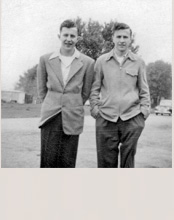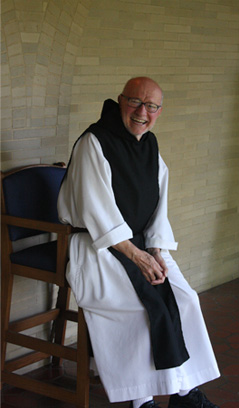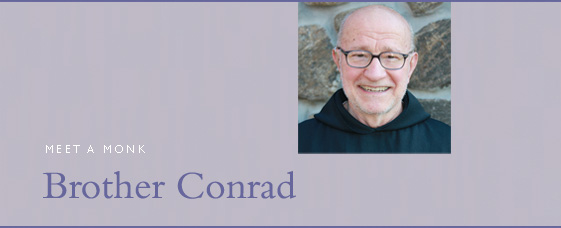 |
at the end of last year, 2007, I celebrated the Golden Jubilee of my monastic profession. It was a very nice day, with our Abbot, Damian Carr, celebrating the Mass and giving the homily. Afterwards a catered meal was served in the cloisters, library, chapter house and garth to about 200 persons—the members of our community and the numerous relatives and guests that had joined us for this special day. It was a very happy occasion for me, especially having five of my nine siblings, a nephew, a niece, a great-nephew and several cousins present, coming from as far away as Minnesota, Texas, New York, California and even Bavaria (Germany).
|
 |
Yes, these fifty years have been quite a ride, as they say. I was born in the Swan Lake area of Nicollet County in southern Minnesota. I was the fifth boy in succession, followed by two girls, a boy, and two more girls. At the time of my birth my parents, Frances (Sondag) and Bill Irrgang, were living on the farm of her parents which was right across the road from the Church of the Visitation, a rural “mission church” belonging to St. Paul’s Parish in Nicollet, some five or six miles away. In fact, it was my grandmother who had ceded the property when this Church of the Visi-tation was started. It was there that I learned to serve Mass and where I attended religious summer school, taught by the School Sisters of Notre Dame, including two of my aunts, Sisters Boniface and Charles.
|
 |
|
I graduated from high school in 1948 (one of seven boys in a class of 23!). There was not much in the way of vocational counseling in those days and I did not have any clear idea of what I wanted to “be”. The thought of becoming a radio announcer or a school teacher had some appeal, but circumstances led me to go to a suburb of Minneapolis where one of my brothers lived and to get a clerical job with the Minneapolis Moline Company, a farm machinery manufacturing company. World War II had taken place from 1941 to 1945, and my four oldest brothers had all served in the Navy. Shortly afterwards the Korean War broke out, and the draft was either still on or on again and, in order not to be drafted into the Army, my next-older brother and I went down to enlist in the Navy. I was not accepted because of a perforated ear-drum.
The Air Force had recently become an independent branch of the Service, and I was accepted there, so off I went to Lackland Air Force Base in Texas for basic training. I then applied for, and was accepted into, a Teletype Operators’ school in Wyoming, and after that was sent to Elmendorf Air Force Base in Anchorage, Alaska. I enjoyed the experience of having daylight only from 9 a.m. to 3 p.m. in the winter and, conversely, taking pictures at 11 p.m. in the summer.
|
|

It was while in Alaska that I had the first stirrings of a “call” to religious life or, maybe I should say, to taking action to answer this call. For I do believe that the influence of Sisters Boniface and Charles, my mother’s dedication to church and choir, those years of serving Mass, and similar experiences, were all circumstances through which God’s grace was all along working in me. In any event, when I came home on leave from Alaska, I took back with me two books that I had read earlier on: Thomas Merton’s Seven Storey Mountain and Fr. Raymond’s The Man Who Got Even with God.
|
|
|

|
|
After my tour in Alaska, I was assigned to Stewart Air Force Base in Newburg, New York. There I began to assist at Mass daily and to speak with the chaplain, a Jesuit. I soon wrote to the Abbey of Gethsemani in Kentucky, asking about monasteries and monastic life. They gave me Spencer’s address and I came here on retreat. It happened to be the week after Easter, and I was overwhelmed with the beauty of the liturgical chant. I spoke with old Fr. Raymond, the confessor at the lay retreat house, and then to Fr. William, the novice master for the lay brothers. This was just prior to my discharge from the Air Force after four years of duty. Fr. William suggested a date for my entrance, and I went home to Minnesota and did clerical work in a department store while I spoke with my family and prepared to say my good-byes.
My father had passed away suddenly the previous October at the young age of 57. I had not had the chance to tell him of my desire to become a monk. I’m not sure how he would have taken it since he had not been practicing his Catholic religion. I guess God spared both him and me some heart-break over this. My mother and the rest of the family were happy about my choice of vocation.
|
|
|
So I entered St Joseph’s Abbey in April of 1955, not yet 25 years of age. The community had just moved to Spencer from Valley Falls, Rhode Island, in 1952 and the retreat house was still under construction at the time. In this period after World War II there was a large influx of new vocations, so that the community had around 100 members. My temperament was such that I more or less fell into the daily routine of the life with relative ease and, after two years in the novitiate, I made my First Profession of Vows on December 15, 1957. My mother and one of my sisters came out from Minnesota to be with me for the occasion.
At this time, too, the Church was setting its sights on Latin America, fearing it was going to be lost to the Church, and our Abbot, Dom Edmund Futterer, had his heart set on making a foundation there. I volunteered to go on the foundation to Argentina and left with the first group of eight monks in October, 1958. It was exciting for me to be a part of this adventure to a new countr
y and culture, a new language and the physicality of doing construction work.
Being on a new foundation allows one to have a variety of monastic work experiences. Mine included wardrobe and laundry, grounds-keeping, cooking, bookkeeping, bee-keeping, and helping with the harvest, among many other jobs.
After more than two decades in Argentina, a number of personal problems arose. While I loved the Argentine people and had learned to speak Spanish quite well, I felt that it would be best for me to return to Spencer to address these unresolved personal issues. And so, after 22 years in Argentina, I came back to St Joseph’s Abbey.
Upon my return I began working in our infirmary and was asked to take a course at Fahning Trade School in Worcester, and so (at age 50!) I became a Licensed Practical Nurse. This was a very beneficial experience for me because I lived in Worcester during the ten months the course lasted. During this time I would, of course, come back to the monastery periodically, above all for special events. Re-lating to my fellow students was a broadening experience.
On completion of the course, I was put in charge of our monastery infirmary. I enjoyed nursing very much, working with the patients, the other monks on the staff, and the visiting doctors. The most important part of the experience was being by the bedside of the monks who passed away during these years and interacting with the Hospice people who would come to help us at critical moments.
|
|

After some nine years of working in the infirmary, however, it all became somewhat overwhelming for me, and I was in need of attaining a new level of peace and confidence, both with myself and with my community. A large part in this process of coming to a place of interior peace was played by the practice of Centering Prayer. I love the monastic Liturgy, and the singing and praying of the Hours of the Di-vine Office; but, for my personal practice, Centering Prayer and the practice of Awareness have been indispensable. Thankfully, St. Joseph’s Abbey has had some great teachers of this type of prayer in the persons of Dom Thomas Keating, Fr. William Menninger and Fr. Basil Pennington.
Externally this latter part of my monastic life has been rather simple. A short stint in the Abbey Gift Shop and now as Sub-Cellarer, are jobs that have suited me well. Yes, these fifty-plus years have been “quite a ride”! As I said in the memorial card for my Jubilee, I am grateful to God, my family and my community. These fifty years have been nothing more and nothing less than a continual unfolding and developing of those three relationships: with my God through personal and communal (liturgical) prayer; with my family through visits, letters, e-mail and my hobby of genealogy; with my community through our shared monastic living and personal friendships. I can’t imagine what my life would be like if I had not had the opportunity our monastic life offers to ponder, to be with, to watch unfold, the mystery of God, of Christ, of Life.
|
|







